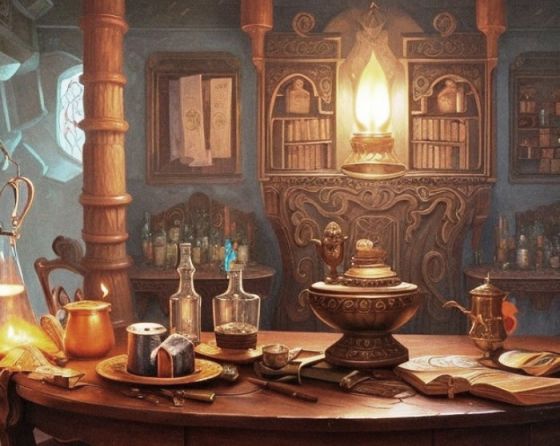Difference between revisions of "Assay (sage ability)"
Tao alexis (talk | contribs) |
|||
| (3 intermediate revisions by one other user not shown) | |||
| Line 1: | Line 1: | ||
| − | '''Assay''' is an [[Knowledge Points|amateur]]-status [[Sage Ability|sage ability]] in the [[Sage Study|study]] of [[Geology (sage study)|Geology]] | + | [[File:Assayer (sage ability).jpg|right|560px|thumb]] |
| + | '''Assay''' is an [[Knowledge Points|amateur]]-status [[Sage Ability|sage ability]] in the [[Sage Study|study]] of [[Geology (sage study)|Geology]] that enables the crucial skill of determining the composition and purity of mineral ores. The character is thus able to establish the quantity of precious metals, like gold or silver, within a particular ore sample. Gemstones and value of same can also be determined. | ||
| + | __TOC__ | ||
| + | Assayers are assumed to possess a foundational knowledge and understanding of the common ores in the region and their typical appearances; the behavior of various metals when exposed to heat, [[Acid (substance)|acid]] or other chemicals; and basic arithmetic to calculate percentages or ratios of metal content. | ||
| − | + | == Tools and Process == | |
| + | Detailed, precise assessment of all contents requires the use of a [[Laboratory|laboratory]] that includes a mortar and pestle, a means of heating ore in a furnace, tongs and heat-resistant tools, a small store of lead metal, balance scales, a crucible called a "cupel," a touchstone and acid vials containing vitriol and aqua regia. | ||
| − | The | + | Before any chemical processes, the assayer visually inspects the ore for telltale signs of valuable metals or impurities. This includes looking at color, texture, and weight. A heavy ore, for instance, indicates the presence of a denser metal. The ore is crushed into a fine powder using a mortar and pestle. This makes it easier to separate the constituents of the ore. A sample of the metal on a touchstone (a smooth, dark stone) and comparing the streak it leaves behind with streaks from metals of known purity. |
| + | One of the primary methods of assaying in the medieval era, '''cupellation''' involves heating the ore in a furnace to separate the base metals from the precious ones. The ore is mixed with lead and placed in a cupel (a porous crucible). When heated, the lead oxidizes and is absorbed by the cupel, leaving behind a bead of precious metal. In some cases assayer uses a balance and scale to compare the weight of the ore in air versus its weight in water. This provides information about its density and, by extension, its purity. | ||
| − | [[Category: Sage Abilities]] | + | Medieval assayers also have access to some basic acids. By noting how the ore or metal reacts when exposed to the acid, the assayer makes judgments about its composition. |
| + | |||
| + | |||
| + | See [[Goldmaven (sage ability)]] | ||
| + | |||
| + | [[Category: Sage Abilities]][[Category: Reviewed]] | ||
Latest revision as of 21:01, 29 October 2023
Assay is an amateur-status sage ability in the study of Geology that enables the crucial skill of determining the composition and purity of mineral ores. The character is thus able to establish the quantity of precious metals, like gold or silver, within a particular ore sample. Gemstones and value of same can also be determined.
Contents
Assayers are assumed to possess a foundational knowledge and understanding of the common ores in the region and their typical appearances; the behavior of various metals when exposed to heat, acid or other chemicals; and basic arithmetic to calculate percentages or ratios of metal content.
Tools and Process
Detailed, precise assessment of all contents requires the use of a laboratory that includes a mortar and pestle, a means of heating ore in a furnace, tongs and heat-resistant tools, a small store of lead metal, balance scales, a crucible called a "cupel," a touchstone and acid vials containing vitriol and aqua regia.
Before any chemical processes, the assayer visually inspects the ore for telltale signs of valuable metals or impurities. This includes looking at color, texture, and weight. A heavy ore, for instance, indicates the presence of a denser metal. The ore is crushed into a fine powder using a mortar and pestle. This makes it easier to separate the constituents of the ore. A sample of the metal on a touchstone (a smooth, dark stone) and comparing the streak it leaves behind with streaks from metals of known purity.
One of the primary methods of assaying in the medieval era, cupellation involves heating the ore in a furnace to separate the base metals from the precious ones. The ore is mixed with lead and placed in a cupel (a porous crucible). When heated, the lead oxidizes and is absorbed by the cupel, leaving behind a bead of precious metal. In some cases assayer uses a balance and scale to compare the weight of the ore in air versus its weight in water. This provides information about its density and, by extension, its purity.
Medieval assayers also have access to some basic acids. By noting how the ore or metal reacts when exposed to the acid, the assayer makes judgments about its composition.
